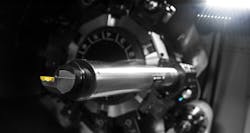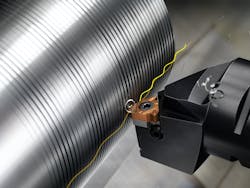Tooling manufacturer helps machines capitalize on data analytics
Sandvik Coromant works with computerized-numerical-control (CNC) and milling-machine customers to improve their production through data analytics. Like many hardware manufacturers, Sandvik Coromant, most known for its tooling, has expanded more into cloud-based machine monitoring systems, morphing into a software and systems provider. More tooling from Sandvik Coromant is incorporating sensors. This next generation of tooling and other software can provide production, quality and even maintenance data on cutting applications, and the CoroPlus Machining Insights can spearhead data-driven process improvements with real-time analytics.
About five years ago, Sandvik Coromant began offering software services, which are used in a variety of different industries, including aerospace and automotive.
Cory Carpenter, digital enablement specialist at Sandvik Coromant, says the company works in partnership with original equipment manufacturers (OEMs). “We have partnerships with them to understand how their machines communicate, and how our system needs to be able to communicate with each other,” Carpenter says. Many OEMs do provide their own monitoring systems for their specific brands, but one advantage of the CoroPlus open platform, Carpenter says, is it can work with a variety of different machine brands, as well as machine types, beyond just traditional CNC lathes and mills.
The company also provides other support services, such as engineering design, computer-aided design (CAD) or computer-aided manufacturing (CAM) support and lean consultancy services.The following five case studies use Sandvik Coromant CoroPlus Machining insights and its embedded tooling (Figure 1) to improve inefficiency by reducing unnecessary manual operation, by decreasing chip-to-chip time, by enabling automated probing systems, by monitoring unmanned operations at night and by monitoring tools for maintenance issues to avoid breakage.
Monitoring machine door open times
In the metal cutting process, chips are removed from a block of material to create the end component, and many different tools create different features in the block, depending on the complexity of the part (Figure 2). “All those chips fall down into the machine and then, there’s an internal conveyor that takes it out of the machine,” Carpenter says. “A chip is the netted-out material that creates the part or the feature needed, essentially the waste of the process from a material standpoint.”In high-production machine shops, efficiency rates are measured in chip-to-chip time, and time spent with the machine door open reduces the time spent making parts. Doors can be opened for a variety of necessary reasons, such as to put in new material, clean out or set up the work area, index the tools or do quality checks, before the machine is ready to start making a new part and start making chips.
The time it takes to start a new part is the chip-to-chip time. “It’s basically the transition from the end of the last part to the start of a new part, and decreasing that time helps utilize machines better and gets parts out the door quicker,” Carpenter says.
One CNC machine shop might want to better understand how many parts were possible to machine in a given time. Perhaps the shop used calendar hours and a theoretical standard work per part. To truly understand how many parts were possible to produce, the customer would need to start with calendar hours available and net out open-door hours to get a baseline of possible hours remaining to cut chips. With the Sandvik Coromant software, the machine shop would have the ability to know exactly how long the doors were open. Having data about door open times also helped isolate other factors in the machine operation that were influencing chip-to-chip time.
“Our system starts to create an understanding of how much time is lost from that door being opened for those operator responsibilities,” Carpenter says. This may serve as financial justification to purchase robots or other machines to reduce that chip-to-chip time, such as multi-tasking machines that can do multiple operations with a second spindle.
Automated probing systems
Probing systems help CNC machines with product quality and the efficiency of running parts. Using a programmed probing routine at the beginning of a cycle ensures accurate cuts each time.
“Probing is basically an in-process measuring system. You’re taking a probe or a sensor that’s going to touch the part and feed you back a value,” Carpenter says. During the probing cycle, each feature is assigned a value range, and the machine can automatically measure each part, serving as a verification.
The probing system can also be used to help drive machine offsets, Carpenter says. If the machine measures a part that is 10.1 inches and it needs to be 10.05 inches, the machine will make a .05-inch adjustment on that tool for the next part. “It’s a way to do verification adjustments and automation within the process. This is being used more and more, especially on high-value parts, take aerospace, for instance,” Carpenter says. Aerospace manufacturers have parts that are hundreds of thousands of dollars per piece, which need full verification before they even come off the machine. “Because as you unfixture things and put them back, it’s impossible to get them in the exact same fixturing position, so they want to make sure it’s right before it comes off the machine,” Carpenter says.
Traditionally, CNC part verification was done by taking a caliper or measurement device, opening the door and taking a measurement, then making adjustments from the manual measurements. For some machine shops, this requires a culture change. “There’s a lot of accountability in these manufacturing processes. Again, depending on the industry segment, these are very expensive parts. People want to do a good job, and they have a hard time trusting new technologies, new methodologies, new ways of working,” Carpenter says. “The other part of that culture change was not only accepting that the technology could do it, but that it could also do it faster. The system isn’t meant to be Big Brother or a stick. It’s supposed to provide a voice to the frontline workers to address what’s prohibiting them from getting more parts out the door,” Carpenter says. “They use the system to show that the probing cycle is actually quicker, so they have the data to talk about it.”
Even in the most advanced industries, machining the most precision, expensive parts, technology still faces challenges from an old-guard culture that’s hesitant to adopt new technology and new ways of working.
Feedrate override knob inefficiency
Operators use the override knob to run CNC machines manually, overriding the tool’s automated programming. Many times, this is done temporarily to prove out a new program, or, for example, in adjusting to a new lot of material with a higher hardness and heat treatment. “As your cutting, there’s more heat. It’s going to wear tools,” Carpenter says. Operators test new materials and set up new tools manually before the machine takes over.
There can be times when it’s needed, but even for the right reasons, overriding and slowing the CNC machine feedrate will obviously slow production and increase cost by reducing tool life.
Sandvik Coromant’s Machining Insights program helped reduce manual override hours. When the override was below target, an automatic notification goes out to programming and operations teams to alert them of the feedrate reduction.
“You create that awareness. You create that understanding, addressing those, we call them mosquitoes, the interruptions that happen at lower magnitude but higher frequencies that cause just as much time and interruption and inefficiency in the process as the large ticket items that everyone is aware of. These are the ones that people aren’t as aware of, and it brings those to light.”
Unmanned robotic cell loading
Many CNC operations use a robotic cell to load machines for reliable operation after hours or for unmanned weekend production. The robot feeds the machine and can properly orient the blanks in the fixture using a vision camera. These overnight operations do not typically require tooling changes, and robots autonomously feed the machine without operators throughout the night.
A CNC user might be having problems with the camera alarm going off overnight, which stopped the robot until an operator came to work, and very few parts were made. The quick fix during normal daytime operations would be to reset the camera and try another blank. “Those are workarounds that people tend to create just to get through the process, but the root cause wasn’t addressed,” Carpenter says.
The Machining Insights program provides a voice for the frontline workers and helps to identify the cause of the reoccurring issue, so it could be solved for the long term (Figure 3). Each machine in the program has a digital logbook, where operators make comments. Through that data, the analytics can identify common issues, such as a camera sensor error that shuts down production on the weekend. It can calculate the equivalent downtime and cost of inefficiency and, most importantly, alert to maintenance issues.The system can also automate the maintenance process, by notifying engineers via the ticket-management system when repairs are needed.
Cooling broken tooling on repeat
Analytics can be used to narrow down the frequency of machine breakdowns and, ultimately, find the root cause and improve production. When a mill randomly breaks its 1/8-inch carbide drill, sometimes up to three times a day, and the machined part was rendered useless with a broken hole, there’s a cost.
When a tool breakage happens, the CoroPlus Machining Insights program allows operators to log the occurrence, providing an understanding of how much time is allocated toward tool breakages. The system can also create an alert and notification. For drilling operations, coolant helps maintain favorable temperatures and subdue pressures. “As you’re drilling the hole, if you don’t have enough coolant to get those chips out as you’re going deeper, it has a tendency to bog down and can end up creating too much force or pressure and snap the tool,” Carpenter says. This could also potentially damage expensive parts.
For the milling machine, once programmers were alerted to tool breakage, they could talk with operators about what happened, which helped shed light on the cause and remove the randomness. It was a simple program fix to use the appropriate amount of coolant during machine operation. In retrospect, this can provide analytics about the total impact for future planning. In real time, it can also act as a support function during machine operation. With the data in totality, notifications can be tailored to specific manufacturing support personnel or for specific maintenance functions.
For more on Sandvik Coromant’s sensor-embedded tooling and software, read this story.
About the Author
Anna Townshend
Managing Editor
Anna Townshend has been a writer and journalist for 20 years. Previously, she was the editor of Marina Dock Age and International Dredging Review, until she joined Endeavor Business Media in June 2020. She is the managing editor of Control Design and Plant Services.

Leaders relevant to this article:




